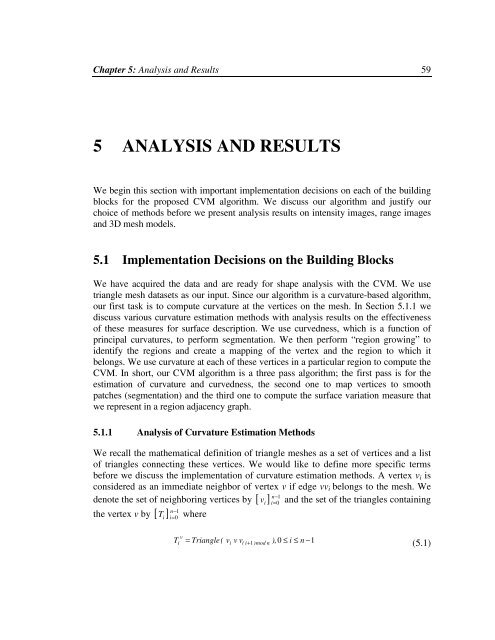To the Graduate Council: I am submitting herewith a thesis written by ...
To the Graduate Council: I am submitting herewith a thesis written by ...
To the Graduate Council: I am submitting herewith a thesis written by ...
Create successful ePaper yourself
Turn your PDF publications into a flip-book with our unique Google optimized e-Paper software.
Chapter 5: Analysis and Results 595 ANALYSIS AND RESULTSWe begin this section with important implementation decisions on each of <strong>the</strong> buildingblocks for <strong>the</strong> proposed CVM algorithm. We discuss our algorithm and justify ourchoice of methods before we present analysis results on intensity images, range imagesand 3D mesh models.5.1 Implementation Decisions on <strong>the</strong> Building BlocksWe have acquired <strong>the</strong> data and are ready for shape analysis with <strong>the</strong> CVM. We usetriangle mesh datasets as our input. Since our algorithm is a curvature-based algorithm,our first task is to compute curvature at <strong>the</strong> vertices on <strong>the</strong> mesh. In Section 5.1.1 wediscuss various curvature estimation methods with analysis results on <strong>the</strong> effectivenessof <strong>the</strong>se measures for surface description. We use curvedness, which is a function ofprincipal curvatures, to perform segmentation. We <strong>the</strong>n perform “region growing” toidentify <strong>the</strong> regions and create a mapping of <strong>the</strong> vertex and <strong>the</strong> region to which itbelongs. We use curvature at each of <strong>the</strong>se vertices in a particular region to compute <strong>the</strong>CVM. In short, our CVM algorithm is a three pass algorithm; <strong>the</strong> first pass is for <strong>the</strong>estimation of curvature and curvedness, <strong>the</strong> second one to map vertices to smoothpatches (segmentation) and <strong>the</strong> third one to compute <strong>the</strong> surface variation measure thatwe represent in a region adjacency graph.5.1.1 Analysis of Curvature Estimation MethodsWe recall <strong>the</strong> ma<strong>the</strong>matical definition of triangle meshes as a set of vertices and a listof triangles connecting <strong>the</strong>se vertices. We would like to define more specific termsbefore we discuss <strong>the</strong> implementation of curvature estimation methods. A vertex v i isconsidered as an immediate neighbor of vertex v if edge vv i belongs to <strong>the</strong> mesh. Wen−v and <strong>the</strong> set of <strong>the</strong> triangles containingdenote <strong>the</strong> set of neighboring vertices <strong>by</strong> [ ]1n−1<strong>the</strong> vertex v <strong>by</strong> [ ]i i=0T i i=0 where 1vTi = Triangle( viv v( i+ 1)modn ), 0 ≤ i ≤ n −(5.1)
















